Details about the device of the bicycle and its components

Many people know how a bicycle works from childhood, but in general terms. For example, like this: it consists of what we see, that is - from wheels, frame, fenders, pedals, chain and steering wheel. In our article, we will dwell in more detail on the anatomy of bikes, find out the name of its main parts and their purpose, and also give recommendations on choosing the basic structural elements of a two-wheeled vehicle.

Bicycle frame types
Describing the structure of bicycles is the best place to start. with an overview of the frames, since it is this element that is the main one in the structure of a two-wheeled vehicle. Depending on the design, it can be open or closed. A distinctive feature of closed frames is the straight top tube, in the open version it is located at the bottom and has a slightly curved shape - this frame is specially designed for female users.
The overwhelming majority of modern velor is made of aluminum, but you can find products from other materials. Each of them has its own pros and cons.

So, steel structures are functional, reliable and practical only if they are made of chromium-molybdenum alloys. All other types of steel, unfortunately, leave much to be desired: they are bulky, heavy and do not differ in durability.


Aluminum captivates with its low weight, therefore, frames made of this metal are commonly used in the production of racing bikes. At the same time, aluminum is more susceptible to destruction, and most often this happens unexpectedly.

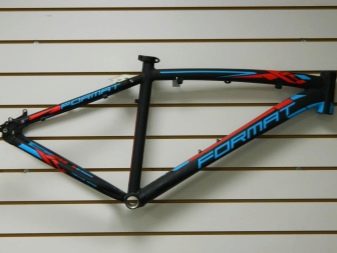
And here titanium frames are not afraid of either cold or heat. They are not afraid of aggressive acid-base solutions, which is why their use differs in duration.
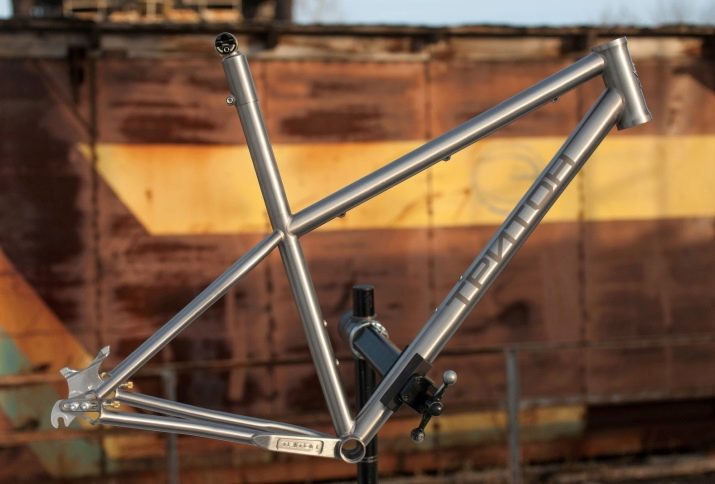
Magnesium is another light metal, but it corrodes.Therefore, it is very important for the user to ensure that no chips or scratches appear on the bike frame.

The most durable and at the same time lightweight are carbon frames. But a sharp, pinpoint impact can cause quite serious damage to them - such bicycles must be handled as carefully as possible. Manufacturing carbon is high-tech and expensive, which is why there are not many companies in this segment offering bikes with carbon frames.


Depending on the characteristics of the rear wheel shock-absorbing mechanism, bike frame can be active or passive. Passive means the complete absence of separate hinges intended for use under increased load. Passive cushioning is the result of the natural flexibility of the material from which the bike frame is made. These bikes are called hardtails.
Active damping design involves moving parts (hinges or hinge systems), commonly referred to as suspensions.

Active frame bicycles are divided into single-link and multi-link. A single-link suspension is characterized by the fact that the movement of the wheel in this case is carried out around one point, which remains static, regardless of the characteristics of the suspension travel. In a multi-link suspension, on the other hand, the wheel rotates around a point that can change its position.
The operation of this or that transport equipment directly depends on the planned type of driving. For example, when creating a frame for cross-country, manufacturers sought to make it extremely ergonomic and lightweight, which allows riders to take a comfortable position for free pedaling without unnecessary expenditure of physical energy when moving excess weight.
It is for this reason that driving frames in this style are most often made for hardtails in order to save on the mass of the shock absorber and all elements in order to strengthen the bike frame.


Wheel arrangement
Bicycle wheels are lightweight yet fairly durable structures. They distribute the energy of movement, therefore, by means of their rotation, they allow you to keep the bicycle frame in an exact vertical position. Most bicycles are rear-wheel drive, with the rear wheel providing propulsion and the front wheel driven.
Any bicycle wheel includes several structural parts.
- Sleeve... This is the center piece that includes the axle, bearings and rim. The hub is responsible for generating and maintaining enough torque to drive the bike. The internal layout of the rear hubs is a little more complicated than that of the front wheels, since they take part in the forced unwinding of the entire wheel.

- Rim. A metal ring into which the knitting needles are inserted. This element determines the required resistance of the wheel to any dynamic loads and mechanical damage. The rim is usually made of alloys and plated with a chromium sputter.

- Bicycle tires... Includes a camera as well as tires. The chamber is made of hollow rubber, and is pumped with air until the required pressure is created. It interacts with the outside environment through a nipple, through which air enters the inside of the tires by means of a pump or compressor.
To effectively protect the integrity of the chamber from pointed spokes, a special rubberized flipper is attached to the inner surface of the rim.


The outer surface of a tire is called a tire, and its component parts are beads, sidewalls, and tread. Depending on the operational capabilities of the bike, there are several types of tires:
- slicks and semisliks - such options are optimal for flat tracks, therefore they are most often installed on road bikes;
- road - these include tires with a medium-sized pattern, similar models are installed on mountain bikes;
- hybrid - such tires are effective both in off-road conditions and on a flat track, although they are inferior in cross-country ability to more aggressive options.




To make the bike visible in the dark, a luminous plate of bright orange color - a reflector - is attached to the spokes. According to traffic rules, reflectors must be present on all types of bikes.
The characteristics of tires largely determine the overall riding experience, so special attention should be paid to their choice. First you need to estimate the size of the element, as a rule, it is indicated by two pairs of numbers: the first of them determines the diameter of the wheel, and the second indicates the width of the tire itself. For example, a tire labeled 26x2.1 is used for standard 26 "x 2.1" wide wheels. Wherein the wider the tire, the more firmly it will hold the bike around corners, although it will significantly lose in rolling.

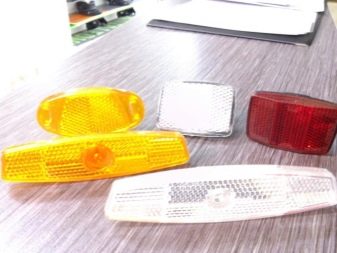
Keep in mind: the less pronounced the tread pattern, the harder the road the tire is designed for. Thus, the most "toothy" pattern will be acceptable for operation on clay, off-road and mud, but for denser and harder surfaces, you can opt for rubber with a flatter pattern and softened compound.


A compound is a mixture of several types of rubber that provides the required wear resistance, strength and grip characteristics of tires.

Control and damping systems
One of the basic elements of the device is a shock-absorbing mechanism that mitigates shock loads on the frame and other bike structures by damping vibrations... The depreciation system includes several components at once.
Traditionally, the front glass of a bicycle frame is attached through the handlebar stem to the inside of the fork, and the wheel is mounted in its ears. In order to ensure unhindered rotation when cornering, a steering column is mounted in the glass.
What is the steering wheel for, we think, there is no need to explain, but its technical and operational parameters - width, amount of rise, upsweep and backsweep - you need to pay special attention. The latter two provide the necessary backward and upward bend of the steering wheel.
We draw special attention to the fact that a wider steering wheel allows the user to give maximum control over his vehicle and thereby contribute to an increase in control efficiency, but at the same time slow down this very control a little.


Raising the steering wheel ensures the correct position of the rider: the lower it is, the more aggressive the position the rider is forced to take. The upswip and backswip parameters are individual, they often help the simplest metal structure to transform into a physiologically comfortable element in the entire bike circuit. When buying the right steering wheel, it is best to go to a sports store and hold the offered products in your hands, which will allow you to get an idea of what kind of performance parameters will be optimal for you.
Barends are inserted along the edges of the steering wheel - special plugs that help reduce injuries. Do not underestimate the risk that the ends of the bars carry - situations in which users injured their stomach or legs with them are very common.

To prevent the hands from slipping during the ride, the design provides rubberized handles (they are called grips).
In modern models, lock-on grips are installed, which are distinguished by the presence of fixing rings at the ends. This solution greatly facilitates their installation and does not allow the pads to slide off. Simpler models are held together only by friction.


The stem is the part that provides the necessary distance between the handlebars and the frame.... It is fixed to the regulating pipe. Adjustable stems or rigid stems can be fitted on various bike models. Simple bicycles don't have them.

The saddle is mounted in the center of the frame and can be adjusted in height, so users can always choose a comfortable fit. Saddle widths vary depending on the characteristics of the bike. Let's say they are slightly wider on road bikes than on mountain bikes (MTBs).


Transmission and brake design
This is something without which no two-wheeled vehicle will simply go. The transmission is a very complex unit, which consists of a wide variety of mechanisms, namely:
- carriages;
- asterisks;
- pedals;
- connecting rod mechanism;
- bicycle chain;
- shifters;
- various speed switches.


The carriage assembly is located at the bottom of the bike frame. It connects the cranks to the chainrings. The carriage provides unimpeded movement due to the fixed bearings and the thru-axle attached to them.

The connecting rods are the most important elements for the interaction of the carriage with the pedals. They can have several methods of fastening: either square or slotted.

The pedals functionally represent the necessary support for the legs, through which physical efforts are transferred to the cranks. They can be performed in several versions.
- Classic (they are also called platforms). These pedals fit on entry level bikes. In this case, the user can ride in absolutely any shoe - here the grip on the pedal is carried out through friction.
- Contact... These pedals have special inserts that can be used exclusively for specialized shoes.
- Extreme. They are mounted on sports bikes, they are distinguished by the presence of clamps, a fairly wide surface, and an impressive thickness.


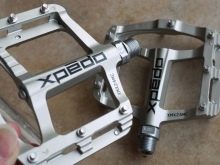
The rear sprockets of the speed bike are fixed to the rear wheel hub. Traditionally, there are a couple of rear sprockets for each front sprocket. When driving, small sprockets provide an upshift, while larger sprockets provide a lower gear.
The connecting piece between them is a chain. Its movement is made through switches, which, in turn, are controlled through the shifters on the steering gear.


Brakes are considered the most important element of the design of any two-wheeled vehicle. In the absence or malfunction of the brake system, it is strictly forbidden to take the vehicle onto the streets by traffic rules.

Modern bike brakes come in several classes.
- Bypass... They are small jigs with shoes. They usually have only one mount.
- Disk. In this design, the pads are fixed to the disc by pressing the handle.
- Drum... This version of the brake system is nowadays considered obsolete. In these bikes, the drum is attached to the rear hub and creates interaction between the pads by pedaling. In order to prevent the mechanism from turning in vain, a stopper is installed in it. The braking performance of such a system is lower than that of the first two, but it is optimal for budget bikes.


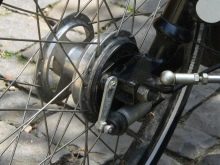
Component overview
When purchasing a bicycle, users often do not pay the necessary attention to spare parts, since the layout of the bike is in most cases provided by the manufacturer.
However, you will certainly be faced with the choice of spare parts in the following situations:
- if you decide to assemble the bike yourself "from scratch";
- if you need to replace worn out parts that are out of order;
- if you decide to upgrade by replacing low-quality components with more functional ones.
When choosing any details it is very important to ensure their maximum correspondence: you must know exactly their size and mounting option, as well as other technical features.
To make the right choice, you can simply take a worn-out part with you or rewrite all its parameters.It will not be superfluous even before buying to clarify which varieties of this or that part can be used for each specific bike.

When choosing components, it is best to opt for products from well-known brands, the quality of which is time-tested. The vast majority of riders buy spare parts for their two-wheeled vehicles Shimano or Sram. In the bicycle parts segment, these two brands are considered monopolies.


The components of the companies Sunday, as well as Fit and United, have good quality. - they are most often chosen by fans of extreme skiing. For high-speed bikes, you can recommend components from Cinelli.


Choosing a well-known brand, you will pay more, but the cost will more than pay off with the practicality and durability of the part.
See below for bike setup.








